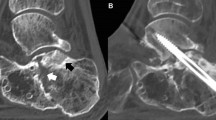Abstract
Purpose
The purpose of this study was to assess the fusion rate on CT examinations and to correlate clinically the functional result with the degree of bone fusion in the subtalar joint after posterior arthroscopic subtalar arthrodesis (PASTA).
Methods
Fourteen cases, from 36 to 84 years old, were retrospectively followed-up for a minimum of one year (range 12–92 months). A CT scan had been systematically performed at the six-month follow-up visit. The CT scans were examined in sagittal 2-mm-thick reformatted slices, measuring the length of the joint surface and the length of the fused portion of the joint space on each image.
Results
At six months, the average fusion ratio was 39±19% (range 0–69%). Fusion defined by a fusion ratio superior or equal to 33% on the CT scan was observed in 11 cases. One patient had a delayed union and required a revision of fixation. One patient had a bilateral nonunion. Mean average AOFAS score improved from 51±10 to 77±9 at last follow-up.
Conclusion
Compared to open procedures, the posterior arthroscopic fusion seems to offer a promising alternative. However, our results suggest that the fusion rate following PASTA is not as favourable as reported in previous studies. Factors such as adequate compression and stable fixation provided by the screws together with the surgeons’ experience with this demanding technique are of the utmost importance. A 33% CT fusion ratio threshold could accurately discriminate between clinical stability and instability.



Similar content being viewed by others
References
Albert A, Deleu PA, Leemrijse T, Maldague P, Devos Bevernage B (2011) Posterior arthroscopic subtalar arthrodesis: Ten cases at one-year follow-up. Orthop Traumatol Surg Res 97:401–405
Amendola A, Lee KB, Saltzman CL, Suh JS (2007) Technique and early experience with posterior arthroscopic subtalar arthrodesis. Foot Ankle Int 28:298–302
Angus P, Cowell H (1986) Triple arthrodesis—A critical long term review. J Bone Joint Surg Br 68:260–265
Beimers L, De Leeuw PA, Van Dijk CN (2009) A 3-portal approach for arthroscopic subtalar arthrodesis. Knee Surg Sports Traumatol Arthrosc 17:830–834
Carro LP, Golanó P, Vega J (2007) Arthroscopic subtalar arthrodesis: the posterior approach in the prone position. Arthroscopy 23:445
Dorsey ML, Liu PT, Roberts CC, Kile TA (2009) Correlation of arthrodesis stability with degree of joint fusion on MDCT. Am J Roentgenol 192:496–499
Easley ME, Trnka HJ, Schon LC, Myerson MS (2000) Isolated subtalar arthrodesis. J Bone Joint Surg Am 82:613–624
El Shazly O, Nassar W, El Badrawy A (2009) Arthroscopic subtalar fusion for post-traumatic subtalar arthritis. Arthroscopy 25:783–787
Glanzmann MC, Sanhueza-Hernandez R (2007) Arthroscopic subtalar arthrodesis for symptomatic osteoarthritis of the hindfoot: a prospective study of 41 cases. Foot Ankle Int 28:2–7
Jones CP, Coughlin MJ, Shurnas PS (2006) Prospective CT scan evaluation of hindfoot nonunions treated with revision surgery and low-intensity ultrasound stimulation. Foot Ankle Int 27:229–235
Kitaoka HB, Alexander IJ, Adelaar RS, Nunley JA, Myerson MS, Sanders M (1994) Clinical rating systems for the ankle-hindfoot, midfoot, hallux, and lesser toes. Foot Ankle Int 15:349–353
Lee KB, Park CH, Seon JK, Kim MS (2010) Arthroscopic subtalar arthrodesis using a posterior 2-portal approach in the prone position. Arthroscopy 26:230–238
Scranton PE Jr (1999) Comparison of open isolated subtalar arthrodesis with autogenous bone graft versus outpatient arthroscopic subtalar arthrodesis using injectable bone morphogenic protein-enhanced graft. Foot Ankle Int 20:162–165
Tasto JP (2006) Arthroscopy of the subtalar joint and arthroscopic subtalar arthrodesis. Instr Course Lect 55:555–564
Van Dijk CN, Scholten PE, Krips R (2000) A 2-portal endoscopic approach for diagnosis and treatment of posterior ankle pathology. Arthroscopy 16:871–876
Author information
Authors and Affiliations
Corresponding author
Additional information
Financial disclosure
No author or related institution has received any financial benefit from research in this study.
Rights and permissions
About this article
Cite this article
Thaunat, M., Bajard, X., Boisrenoult, P. et al. Computer Tomography assessment of the fusion rate after posterior arthroscopic subtalar arthrodesis. International Orthopaedics (SICOT) 36, 1005–1010 (2012). https://doi.org/10.1007/s00264-011-1448-7
Received:
Accepted:
Published:
Issue Date:
DOI: https://doi.org/10.1007/s00264-011-1448-7




